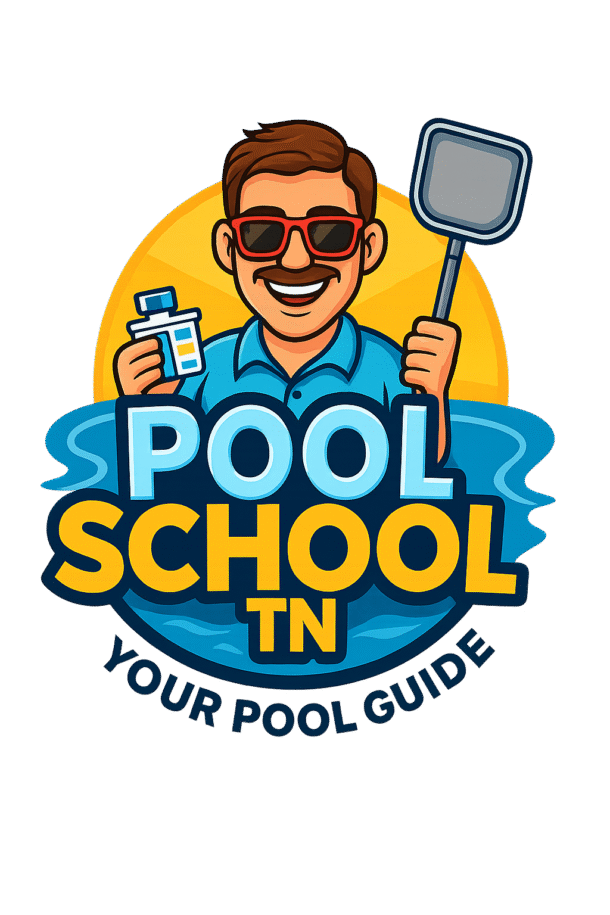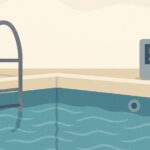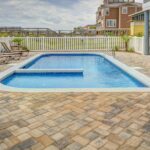Hot tubs provide relaxation and therapy, but they also present unique challenges that many Tennessee owners underestimate. Unlike pools, hot tubs are small, hot environments where problems develop rapidly and can become dangerous quickly. After helping numerous Tennessee hot tub owners recover from serious water quality and health issues, I want to share the critical knowledge you need to maintain safe, clear, and healthy spa water.
The stakes are higher with hot tubs than pools. What might be a minor inconvenience in a 20,000-gallon pool can become a serious health hazard in a 400-gallon hot tub. Understanding these differences and maintaining proper care routines isn’t just about comfort – it’s about protecting your health and your family’s safety.
🌡️ Hot Tub Reality: “A hot tub isn’t a small pool – it’s a completely different environment that requires more attention, not less.”
Why Hot Tubs Require Intensive Maintenance

The Small Volume Challenge
Hot tub volumes typically range:
- 2-person spas: 200-300 gallons
- 4-person spas: 300-450 gallons
- 6+ person spas: 450-650 gallons
Compared to pools:
- Small residential pools: 10,000-15,000 gallons
- Average pools: 20,000-30,000 gallons
- Large pools: 30,000+ gallons
Why size matters critically: With 30-50 times less water volume, hot tubs experience rapid changes that would be gradual in pools. Every bather, every chemical addition, and every contaminant has dramatically amplified effects.
The Heat Factor

Hot tub temperatures (98-104°F) accelerate everything:
- Chemical reactions happen 2-3 times faster
- Bacterial growth doubles every 20 minutes in ideal conditions
- Chemical consumption increases exponentially
- Evaporation rates concentrate chemicals rapidly
- Organic matter breakdown happens much faster
Tennessee climate amplification: Our hot, humid summers make these effects even more pronounced. High ambient temperatures stress hot tub systems, while humidity affects chemical stability and evaporation patterns.
The Bather Load Impact
Hot tub bather density vs pools:
- Hot tub: 4 people in 400 gallons = 1 person per 100 gallons
- Pool: 4 people in 20,000 gallons = 1 person per 5,000 gallons
- Impact ratio: 50 times more concentrated human contamination
What bathers introduce:
- Body oils, lotions, and cosmetics
- Soap residues and shampoo
- Bacteria and other microorganisms
- Organic nitrogen compounds
- Perspiration and dead skin cells
⚗️ Chemistry Reality: “Every person in your hot tub has the chemical impact of 50 people in your pool.”
Essential Hot Tub Water Testing Schedule

Daily Testing (During Regular Use)
Minimum daily tests:
- Free chlorine or bromine levels
- pH levels
- Visual water clarity inspection
Why daily testing is crucial: Hot tub chemistry can go from perfect to dangerous in 12-24 hours. Unlike pools where you might have days to catch problems, hot tubs require immediate attention.
Weekly Comprehensive Testing
Complete weekly analysis:
- Free and total sanitizer levels
- pH and total alkalinity
- Calcium hardness
- Total dissolved solids (TDS)
- Visual equipment inspection
Monthly Professional Analysis
Professional testing should include:
- Bacterial counts and water quality analysis
- Equipment calibration verification
- Filter condition assessment
- Plumbing and jet system inspection
Tennessee recommendation: Have your spa water professionally analyzed monthly during heavy use seasons, bi-monthly during lighter use periods.
Critical Water Balance Parameters
Sanitizer Levels – Your First Line of Defense
Chlorine Systems
- Free chlorine range: 3-5 ppm (higher than pools)
- Why higher levels: Hot water and bather density require stronger sanitization
- Testing frequency: Minimum twice daily during use
Bromine Systems (Preferred for Hot Tubs)
- Bromine range: 4-6 ppm
- Advantages: More stable in hot water, less odor, gentler on skin
- Regeneration: Use bromine tablets with mineral systems for consistent levels
pH Control – More Critical Than Pools
Target range: 7.2-7.6 (same as pools but more critical to maintain)
Why pH matters more in hot tubs:
- High temperatures make pH swings more dramatic
- Small volume means rapid changes
- High bather density affects pH constantly
- Equipment damage happens faster with poor pH
Tennessee hot tub pH challenges:
- Aeration from jets drives pH up constantly
- Heat accelerates pH rise
- Bather contamination affects pH rapidly
Total Alkalinity – Your Stability Buffer
Target range: 80-120 ppm Hot tub importance: Prevents rapid pH swings that are dangerous in small, hot environments
Calcium Hardness – Equipment Protection
Target range: 150-300 ppm Hot tub considerations: Too low causes equipment corrosion, too high causes scale in heating elements and jets
Total Dissolved Solids (TDS) – The Hidden Problem
Maximum safe level: 1,500 ppm above starting water TDS Why TDS matters: High TDS makes sanitizers ineffective and causes skin/eye irritation
When to drain and refill:
- TDS exceeds safe levels
- Water becomes impossible to balance
- Every 3-4 months regardless of TDS (more frequent with heavy use)
The Legionnaires Disease Threat
Understanding the Discovery
Historical context: Legionnaires disease was first identified in 1976 following an outbreak at an American Legion convention in Philadelphia. Of the 4,400 attendees, 221 became seriously ill with pneumonia-like symptoms, and 34 died. The mysterious illness baffled medical experts until CDC scientists Dr. Joseph McDade and Charles Shepard identified the causative bacterium six months later.
The bacteria: Legionella pneumophila was named after the American Legion connection and the pneumonia-like symptoms it caused. This discovery revealed a previously unknown pathogen that thrives in warm, stagnant water systems.
Why this matters for hot tub owners: The same conditions that existed in the Philadelphia hotel’s cooling towers – warm, stagnant water with poor maintenance – can easily develop in poorly maintained hot tubs.
How Legionella Thrives in Hot Tubs
Ideal Legionella conditions:
- Water temperatures: 77-108°F (hot tubs operate at 98-104°F)
- Stagnant water: Poor circulation or filtration
- Biofilm formation: Bacteria colonies on surfaces
- Nutrient availability: Organic matter from bathers
- pH imbalance: Especially alkaline conditions
Tennessee risk factors:
- High humidity supports bacterial growth
- Warm ambient temperatures stress hot tub systems
- Extended use seasons provide more opportunities for contamination
Preventing Legionnaires Disease
Sanitization requirements:
- Maintain minimum 3 ppm free chlorine at all times
- Shock weekly with higher sanitizer doses
- Never allow sanitizer to drop to zero
- Test sanitizer levels twice daily during use periods
Water circulation protocol:
- Run circulation pumps minimum 8-12 hours daily
- Ensure all jets and returns have adequate flow
- Clean and maintain all circulation components
- Eliminate dead zones where water doesn’t circulate
Temperature management:
- Don’t exceed 104°F for extended periods
- Cool water periodically if not in regular use
- Maintain circulation even when not heating
Regular shock and disinfection:
- Weekly shock treatments to break down biofilms
- Monthly deep cleaning of all surfaces
- Quarterly system purges with specialized cleaners
Recognizing Legionnaires Disease Symptoms
Early symptoms (2-10 days after exposure):
- High fever and chills
- Cough (may be dry or produce sputum)
- Shortness of breath
- Muscle aches and headaches
- Fatigue and loss of appetite
Serious symptoms requiring immediate medical attention:
- Severe pneumonia symptoms
- Difficulty breathing
- Chest pain
- Confusion or changes in mental awareness
High-risk individuals:
- Adults over 50
- Smokers or former smokers
- People with chronic lung disease
- Immunocompromised individuals
- Those with underlying health conditions
⚠️ Health Warning: “Legionnaires disease can be fatal. Proper hot tub maintenance isn’t just about comfort – it’s about preventing serious illness.”
Hot Tub Filter Maintenance – Your Primary Defense
Understanding Hot Tub Filtration Demands
Why filters work harder in hot tubs:
- Higher contaminant concentration per gallon
- Continuous filtration requirements
- Hot water carries more dissolved solids
- Small filter surface area handling heavy loads
Filter Cleaning Schedule
Weekly Filter Maintenance
- Remove filters and rinse with garden hose
- Spray with filter cleaner and let soak 15 minutes
- Rinse thoroughly until water runs clear
- Rotate filter sets if you have spares
- Inspect for damage or excessive wear
Monthly Deep Cleaning
- Soak filters overnight in filter cleaning solution
- Use soft brush to remove stubborn debris
- Rinse thoroughly with clean water
- Allow filters to dry completely before reinstalling
- Inspect filter housing and clean if needed
Chemical Filter Cleaning
Every 6-8 weeks:
- Remove organic buildup with enzyme cleaner
- Remove mineral deposits with acidic cleaner
- Rinse between treatments to prevent chemical reactions
- Never mix different cleaners simultaneously
When to Replace Hot Tub Filters
Replacement indicators:
- Filter fabric is discolored and won’t clean white
- Pleats are damaged or coming apart
- Filter housing cracks or warps
- Cleaning frequency increases dramatically
- Water quality suffers despite proper chemical balance
Typical replacement schedule:
- Heavy use (daily): Every 6-8 weeks
- Moderate use (3-4 times weekly): Every 8-12 weeks
- Light use (weekly): Every 12-16 weeks
- Seasonal use: At start and end of each season
Tennessee considerations:
- High pollen seasons may require more frequent replacement
- Extended use seasons increase filter wear
- Heat and humidity can accelerate filter degradation
Filter Purchasing Strategy
Always maintain spare filter sets:
- Minimum: One complete spare set
- Recommended: Two complete spare sets for continuous rotation
- Benefits: Always have clean filters available, extend filter life through rotation
Quality matters:
- OEM filters: Best fit and performance
- Quality aftermarket: Ensure proper specifications
- Avoid cheap imitations: Poor filtration and short life
Hot Tub Equipment and Parts Sourcing
The Brand Reliability Challenge
Why equipment sourcing matters: Hot tub manufacturers come and go, leaving owners with orphaned equipment. Unlike pool equipment with standardized components, hot tub parts are often brand-specific and may become unavailable when companies fail or change ownership.
Researching Your Hot Tub Brand
Before purchasing replacement parts:
- Identify exact model and year of your hot tub
- Research manufacturer status – Are they still in business?
- Locate authorized dealers in Tennessee
- Find parts compatibility information
- Document all equipment specifications
Tennessee Hot Tub Parts Resources
Local dealer advantages:
- Immediate parts availability
- Professional installation services
- Warranty support and service
- Ongoing relationship for future needs
What to ask potential suppliers:
- How long have you supported this brand?
- Do you stock common replacement parts?
- Can you get parts if the manufacturer discontinues them?
- Do you provide installation and service?
- What’s your warranty on parts and labor?
Common Hot Tub Components and Sourcing
Pumps and Motors
Sourcing considerations:
- Frame size and mounting specifications
- Voltage and amperage requirements
- Wet end compatibility with plumbing
- Control system integration requirements
Heaters and Heating Elements
Critical specifications:
- Wattage and voltage requirements
- Physical size and mounting configuration
- Safety switch integration
- Control panel compatibility
Control Systems
Replacement challenges:
- Programming and setup complexity
- Sensor compatibility requirements
- Wiring harness configurations
- Software and firmware availability
Jets and Plumbing Components
Standardization issues:
- Thread sizes and configurations
- Gasket and seal compatibility
- Flow rate and pressure specifications
- Aesthetic matching requirements
Building Relationships with Suppliers
Establish connections before you need them:
- Visit local hot tub dealers and service companies
- Document your equipment specifications
- Ask about parts availability and lead times
- Understand pricing for common replacement items
Maintain equipment documentation:
- Keep all manuals and warranty information
- Document part numbers and specifications
- Take photos of equipment installations
- Record maintenance and repair history
Water Quality Management Strategies
Startup and Fresh Fill Procedures
New water preparation:
- Test source water for baseline chemistry
- Add stain and scale preventer if needed
- Balance alkalinity first (80-120 ppm)
- Adjust pH to 7.2-7.6 range
- Add initial sanitizer to establish residual
- Allow circulation for 4-6 hours before use
Daily Maintenance Routine
Before each use:
- Test sanitizer and pH levels
- Adjust chemicals if needed
- Visual inspection of water clarity
- Check equipment operation
After each use:
- Add shock treatment if heavy bather load
- Rinse and replace filter if visibly dirty
- Check and adjust sanitizer levels
- Ensure proper circulation
Weekly Intensive Maintenance
Chemical management:
- Complete water analysis and balancing
- Shock treatment to oxidize contaminants
- Algaecide addition if needed
- Enzyme treatment for organic buildup
Physical maintenance:
- Deep clean filters and rotate spares
- Wipe down spa surfaces
- Clean skimmer and drain covers
- Inspect and clean jets
Monthly Deep Maintenance
System cleaning:
- Flush plumbing lines with cleaning product
- Clean and disinfect all surfaces
- Inspect and service equipment
- Professional water analysis
Preventive measures:
- Check all electrical connections
- Lubricate moving parts as needed
- Inspect covers and hardware
- Update maintenance logs
Tennessee Climate Considerations
Summer Challenges
High temperature effects:
- Increased chemical consumption
- Equipment overwork and stress
- Higher evaporation and concentration
- Electrical system strain
Management strategies:
- Increase testing frequency
- Provide equipment shade if possible
- Monitor electrical loads carefully
- Maintain adequate water levels
Winter Considerations
Cold weather protection:
- Freeze protection system operation
- Circulation pump runtime increases
- Cover insulation becomes critical
- Power outage emergency procedures
Seasonal maintenance adjustments:
- Reduced chemical demand but maintain minimums
- Equipment inspection for freeze damage
- Cover cleaning and maintenance
- Emergency preparedness planning
Storm Preparedness
Before severe weather:
- Secure loose equipment and accessories
- Ensure backup power availability if possible
- Stock emergency chemical supplies
- Document equipment conditions
After storm recovery:
- Inspect all equipment for damage
- Test water chemistry immediately
- Check electrical systems safely
- Restore normal operation gradually
Troubleshooting Common Hot Tub Problems
Cloudy Water Issues
Causes specific to hot tubs:
- High TDS from concentrated use
- Filter overload from bather contamination
- Poor circulation in small volume
- Chemical imbalance from rapid changes
Solution approach:
- Test all chemical parameters immediately
- Clean or replace filters if dirty
- Shock treat to oxidize contaminants
- Increase circulation time
- Consider partial water change if TDS is high
Foam Problems
Common causes:
- Soap and detergent residues from swimwear
- Body care products (lotions, oils)
- Poor water balance allowing surfactants
- Organic contamination buildup
Elimination strategy:
- Remove bathers and let foam settle
- Add foam suppressant for immediate relief
- Shock treat to break down organic causes
- Clean filters thoroughly
- Balance water chemistry properly
- Consider water replacement if problem persists
Odor Issues
Chlorine/chemical odors:
- Usually indicate chloramines, not excess chlorine
- Result from inadequate sanitization
- Common with high bather loads
Organic odors:
- Bacterial growth in biofilms
- Organic matter decomposition
- Poor circulation and filtration
Resolution steps:
- Shock treat heavily to break chloramines
- Clean all surfaces and equipment
- Replace filters if contaminated
- Purge plumbing lines with cleaning solution
- Rebalance water chemistry completely
Equipment Malfunctions
Heating problems:
- Check electrical connections and breakers
- Inspect heating elements for scale buildup
- Verify water flow through heater
- Test temperature sensors and controls
Circulation issues:
- Clean filters and check for clogs
- Inspect pump and motor operation
- Verify valve positions and settings
- Check for air locks in plumbing
Control system problems:
- Reset GFCI breakers and test
- Check sensor connections and calibration
- Verify programming and settings
- Consult manufacturer documentation
Safety Protocols and Best Practices
Safe Soaking Guidelines
Temperature limits:
- Maximum 104°F for healthy adults
- Lower temperatures for children, elderly, pregnant women
- Time limits: 15-20 minutes maximum at high temperatures
- Cool-down periods between extended sessions
Health precautions:
- Stay hydrated with water, not alcohol
- Exit immediately if feeling dizzy or nauseous
- Avoid hot tub use with open wounds
- Shower before and after soaking
Chemical Safety
Handling and storage:
- Store chemicals in cool, dry location
- Never mix different chemicals
- Use proper measuring tools
- Wear protection when handling chemicals
- Keep chemicals away from children and pets
Emergency procedures:
- Know location of emergency shut-offs
- Keep first aid supplies accessible
- Have emergency contact numbers available
- Understand basic water rescue techniques
Electrical Safety
GFCI protection:
- Test GFCI devices monthly
- Reset immediately after any trip
- Have qualified electrician inspect annually
- Never operate with GFCI problems
General electrical safety:
- Keep electrical devices away from water
- Don’t operate spa with damaged equipment
- Use only GFCI-protected outlets
- Have electrical work done by licensed professionals
Conclusion
Hot tub maintenance is more demanding than pool care because the stakes are higher and problems develop faster. The combination of small water volume, high temperatures, and concentrated bather loads creates an environment where proper maintenance isn’t just about comfort – it’s about health and safety.
Tennessee’s climate adds additional challenges with high heat, humidity, and extended use seasons that stress both equipment and water chemistry. Success requires understanding these unique demands and adapting maintenance routines accordingly.
The key principles for hot tub success are consistent monitoring, proactive maintenance, and immediate response to problems. Daily testing, weekly deep cleaning, and monthly professional analysis aren’t excessive – they’re the minimum requirements for safe, enjoyable hot tub ownership.
Remember that Legionnaires disease and other waterborne illnesses are real threats that can be prevented through proper maintenance. The cost of maintaining safe water is minimal compared to the health risks and equipment damage that result from neglect.
🎯 Hot Tub Success Formula: “Small volume + high temperature + frequent use = intensive maintenance requirements. There are no shortcuts to safe hot tub operation.”
Whether you’re a new hot tub owner or looking to improve your maintenance routine, following these guidelines will help ensure years of safe, relaxing enjoyment from your spa investment.
New to hot tub ownership or struggling with water quality issues? Share your specific challenges in the comments below. With details about your spa size, usage patterns, and current problems, we can help you develop a maintenance routine that works for Tennessee conditions.







